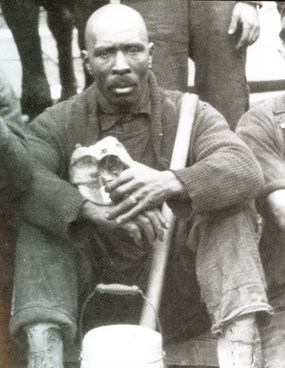
photo courtesy of George Bragg
Between 1870 and 1930, thousands of white people, African Americans, and European immigrants came to West Virginia to work in the coal mines. African Americans migrated to mines throughout the state, but most of them came to work in the smokeless coal fields of southern West Virginia. What they found was the opportunity to build a better life for themselves and their families. By 1909, African Americans made up over 26 percent of West Virginia mine workers. 
Picking and loading coal was hard, dangerous, back-breaking work; however, it provided the greatest opportunity for the miner to earn good money. As coal loaders, black and white miners were paid by the ton of coal mined, not by the hours worked. Hard-working miners could cut and load an average of five tons of coal daily, earning $2.20 to $5.00 per day. Today, a West Virginia miner earns an average of $325.00 for an eight-hour day. For nearly sixty years, coal was mined by hand using a pick, a drill, a needle, and a No. 2 and No. 4 shovel. A miner was required to purchase his tools from the company store. Once the black coal loader was underground, he performed the laborious tasks of cutting, drilling, blasting, and loading coal. William Tams’s describes from his personal knowledge the job of a black coal miner. “The loader carried into the mine his picks, shovels, auger, tamping bar, fuse and a can of black powder. He was charged fifth cents per month for the services of the company blacksmith in re-sharpening and tempering the pick …. After taking two and a half to three hours to make an undercut, the miners drilled, loaded, and fired the holes, bringing down the undercut coal. They then pushed up empty mine cars from the room mouth, loaded them, and returned them to the entry…. The miner put his brass check near the bottom of each car he loaded. The check was removed after the car was dumped at the tipple and the load credited to the proper man.”2 
Once the dust settled, the miner began the laborious task of loading the coal into cars. It was critical that the miner load only clean coal because he was not paid for loading rock. When the car was full, he pushed it to the mouth of his room where it was hauled away to the head house. Before the miner could start a new cut, he had to perform “dead work” for which he received no pay. Dead work involved installing roof supports, maintaining ventilation, and extending the tramway to the coal face. A tramway system similar to a light-duty railroad hauled the coal to the outside. Mule drivers and their brakemen, often African Americans, hauled the loaded coal cars to the mainline. There the cars were made up into trains and hauled to the headhouse. At the headhouse, the coal was weighed and the miner credited for payment. Until the advent of electric motors at the turn of the twentieth century, mules or horses were used to pull coal cars out of the mines. From the mine, some of the coal headed to coke ovens where African Americans performed the hot and laborious job of tending the ovens. They shoveled coal into the ovens, fired the coal, then unloaded the finished coke into train cars, earning an average of $1.60 per day. 1. Dr. Ronald L. Lewis, Black Coal Miners in America: Race, Class, and Community Conflict 1780-1980 , The University Press of Kentucky, 1987. 2.Christopher Wildinson, Big Band Jazz in Black West Virginia, 1930-1942, University Press of Mississippi, Jackson. 2012. Sources Bailey, Kenneth R. “A Judicious Mixture: Negroes and Immigrants in the West Virginia Mines, 1880-1917,” West Virginia History. Black Diamond, Volume 68, No. 25 (June 24, 1922). Lewis, Ronald L. Black Coal Miners in America. University Press of Kentucky, 1987. Miller, Truman I. Miner, A Life Underground. Lexington, KY: Bacchante Books, 2015. Tams . W.P. Jr. The Smokeless Coal Fields of West Virginia. Morgantown, WV: West Virginia University Press, 1963, 2001. Joe Trotter, “Black Migration to Southern West Virginia,” in Transnational West Virginia, editors, Ken Fones-Wolf and Ronald L. Lewis. West Virginia University Press, 2002. White, I.C. Report on Coal, Vol. Two, West Virginia Geological Survey. Morgantown, W.Va.: Morgantown Post Company, 1903. West Virginia Department of Mines, Annual Report, Various, 1883 - 1940. Workman, Michael, “Coal Mining in the United States: A Technological Context,” Institute for History of Technology & Industrial Archaeology, 2000, Unpublished manuscript. U.S. Census, 1900 - 1940, Fayette & Raleigh Counties, manuscript copy, accessed at ancestry.com |
Last updated: January 22, 2020
